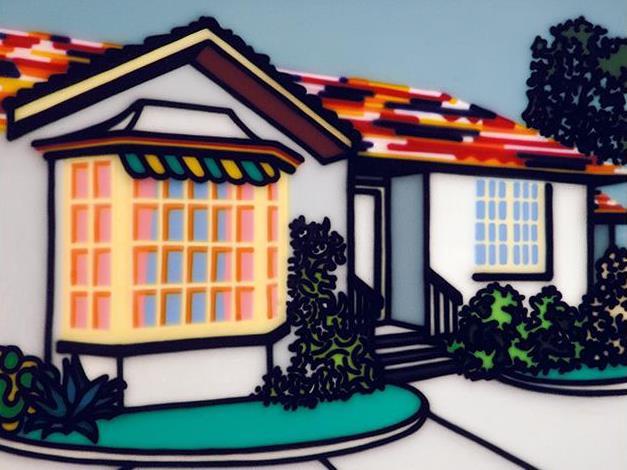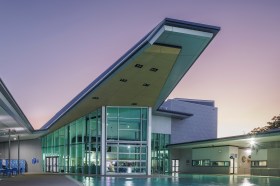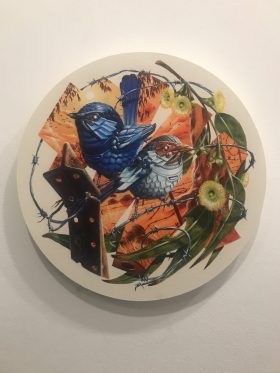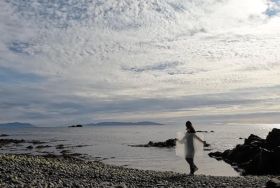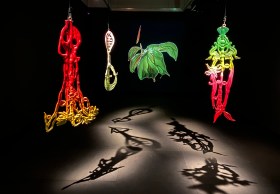Howard Arkley, The Bay Window, 1988, synthetic polymer paint on canvas, 161 x 199.7 cm. Gift of Eva Besen AO and Marc Besen AO. Donated through the Australian Government’s Cultural Gifts Program 2008, TarraWarra Museum of Art collection. © The Estate of Howard Arkley. Courtesy Kalli Rolfe Contemporary Art.
Melbourne’s industria and sprawling suburbs fly by, eventually giving way to a rural vision of farmland and gently rolling hills. Set in the bucolic surrounds of Victoria’s Yarra Valley wine region, an hour’s drive north-east of Melbourne, TarraWarra Museum of Art over looks lush vineyards, the gentle curves of its minimalist architecture reflecting the surrounding topography. Home to an impressive collection of contemporary art, the current exhibition of work by the late Howard Arkley draws from the gallery’s own collection along with works on loan from other public and private collections.
In contrast to its rural setting, the focus of Howard Arkley (And Friends…) is urban landscapes and subcultures; a response to his environment over three decades, spanning a period from the mid 1970s to his death in 1999: the exhibition a metaphor perhaps for a shift in national consciousness from bush to urban identity.
Known for his finely articulated airbrush painting and iconic images of suburban Australia, the curators Anthony Fitzpatrick and Victoria Lynn bring together these and lesser-known works to create a montage of images and influences which capture a sense of the man and his work. Mimicking Arkley’s style of sampling and fusing of ideas and images, the curators have drawn extensively from his archives, on loan from the State Library of Victoria, to give an idea of his creative process.
The gallery’s long rectangular space has been divided in to a series of large areas in which elegant display cabinets present visual diaries, sketch books, photographs, magazine clippings, fashion and hardware catalogues, providing greater depth to the exhibition. This support material reflects Arkley’s interest in research, appropriation, and reworking of images as well as the inspiration, struggles and exploration that lay behind his finished paintings.
Music was also an important source of inspiration for Arkley. Along with didactic panels and labels, each space presents a list of music in conjunction with headphone sets so the viewer can experience the sounds that informed the paintings in front of them. Arkley’s early ‘white works’ of the mid 1970s, like the painting Oriental (Wave Study), (1974), combines precise line with soft airbrush marks to form a vertical patterning through groupings of tone. The painting appears to pulsate to a jazz beat, while others such as Actuality (Is the Void Between Events), (1976) and Organic Model G (Black Square) also (1976) reflect his interest in the experimental music of artists such as John Cage and interest in Eastern religions. These ‘white works’ have an improvised ‘quiet’ in which the spaces between the lines or around the shapes becomes as important as the marks themselves.
In contrast to these earlier works the music and culture of the new wave and punk scene of the late 1970s and early 1980s had a dramatic impact on Arkley’s image making. His response to these influences can be seen in such paintings as the Primitive, series (1981-82) and the Tattoo series (1983). Heavy line work melds a busy array of objects and abstraction into decorative patterning that was to become his trademark.
Some of Arkley’s most resolved and sophisticated works are those of his later suburban interior and exteriors. In these paintings his long held interest in decorative design and patterning come to the fore. Family Home – Suburban Exterior (1993) depicts a triple fronted manicured suburban home. The play of colours and shapes on the garden wall and light on the repeating window planes suggest both play and tension as he explores the notion of the suburban dream; at once compelling and yet soulless in its perfection and anonymity. Ultrakleen, (1992) combines multiple patterned surfaces competing in a kitchen interior from laminex bench top to stenciled pictures, patterned wall paper and marbled pelmet with a checker board linoleum floor and patterned arabesque rug; familiar and yet surreal, inviting but also alien in its extremity.
The artistic scene in which Arkley mingled, worked and lived was an important influence and support for his work. Placed in a hallway that runs the length of the main gallery artistic collaborations with friends such as Juan Davila in mixed media collage on paper (1990, 1992) or a painting of a suburban backyard with Christine Johnson (1987) and others, appears something of an afterthought. Although contextually important in providing a larger picture the strength of the exhibition is its focus on Arkley and in its research and fine curating that gives the viewer an understanding of this complex, compelling artist. Accompanied by a fine hardcover catalogue with essays by John Gregory and Chris McAuliffe this is an exhibition to see.
Rating: 3.5 stars out of 5
Howard Arkley (And Friends…)
Tarrawarra Museum of Art
www.twma.com.au
Until 28 February 2016
